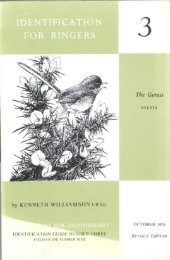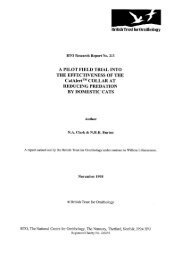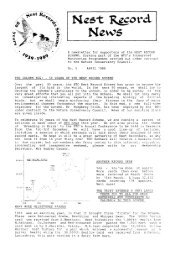Going for Gold: Goldfinch
Going for Gold: Goldfinch
Going for Gold: Goldfinch
Create successful ePaper yourself
Turn your PDF publications into a flip-book with our unique Google optimized e-Paper software.
<strong>Gold</strong>finch, by John Harding and (insert) juvenile <strong>Gold</strong>finch, by Amy Lewis<br />
Identification should<br />
pose few problems.<br />
With its red, white<br />
and black head, the<br />
<strong>Gold</strong>finch looks very<br />
different from other<br />
birds, although young<br />
birds (see insert to<br />
title photograph) lack<br />
these features. The<br />
gold wing panel, black<br />
wings and white wing<br />
tips are, however,<br />
characteristic.<br />
t<br />
<strong>Gold</strong>finch, by Jill Pakenham<br />
18<br />
There can be few birds that are more<br />
charming than the <strong>Gold</strong>finch, with its<br />
clown-like plumage. Even the collective<br />
noun <strong>for</strong> a flock of <strong>Gold</strong>finches is ‘charm’,<br />
although the origins of this association may<br />
actually be linked to the use of the term<br />
<strong>for</strong> the blended voices of a choir – perhaps<br />
alluding to the gentle jingling calls and song<br />
of the <strong>Gold</strong>finch.<br />
The combination of attractive plumage<br />
and a delightful song may be one reason<br />
why <strong>Gold</strong>finches were so popular as cage<br />
birds throughout much of the<br />
19 th Century. Sadly, the practice<br />
of trapping wild <strong>Gold</strong>finches<br />
still goes on in some parts<br />
of Europe, where small<br />
birds are caught in traps<br />
known as chardonnerets –<br />
‘chardonneret’ also being the<br />
French word <strong>for</strong> <strong>Gold</strong>finch.<br />
<strong>Gold</strong>finches feature in<br />
art, particularly in French<br />
and Italian works, where,<br />
<strong>for</strong> example, they are used<br />
as a symbol of fertility<br />
or resurrection in early<br />
devotional paintings.<br />
<strong>Going</strong> <strong>for</strong> <strong>Gold</strong>:<br />
<strong>Gold</strong>finch<br />
by Mike Toms<br />
GOLDFINCHES AND GARDENS<br />
Results from the BTO Garden Bird Feeding<br />
Survey (GBFS) highlight the meteoric<br />
increase in garden use by this species over<br />
the last 25 years. GBFS shows that the mean<br />
peak count <strong>for</strong> <strong>Gold</strong>finch during winter has<br />
risen from just 0.01 birds in 1983/84 to 3.26<br />
birds last winter. Much of this increase is<br />
likely to be linked to the increase in breeding<br />
numbers seen over the same period (data<br />
from the BTO/RSPB/JNCC Breeding Bird<br />
Survey and BTO Common Birds Census<br />
reveal an 85% increase over 25 years). Some<br />
of the change, however, may also be linked<br />
to changes in wintering behaviour.<br />
<strong>Gold</strong>finches are mobile feeders, moving<br />
around to find the seeds that they favour<br />
(typically plants belonging to the family<br />
Asteraceae). Such movements are not just<br />
contained within Britain & Ireland, as birds<br />
may move to the Continent during late<br />
autumn. Interestingly, the birds don’t simply<br />
up sticks and move to a specific wintering<br />
area; instead, they move south and stop<br />
once they find the food and conditions they<br />
are looking <strong>for</strong>. Not all of the British & Irish<br />
breeding population moves, with some<br />
individuals moving in some years but not<br />
Bird Table Autumn 2011
Map taken from Time to Fly, by Jim Flegg and published by the BTO<br />
others, something that is known as ‘partial<br />
migration’. Individual decisions about<br />
whether or not to migrate are linked to<br />
local conditions, age and sex. The increasing<br />
quantities of suitable food now provided in<br />
garden feeders may be exerting an influence<br />
on these migratory decisions. With suitable<br />
food available at garden feeding stations,<br />
coupled with generally warmer winters,<br />
<strong>Gold</strong>finches may remain here instead of<br />
moving south.<br />
SEED PREFERENCES<br />
Take a close look at the bill of a <strong>Gold</strong>finch<br />
and you should notice that it is rather long<br />
and thin, compared to our other common<br />
finches. This allows the <strong>Gold</strong>finch to extract<br />
seeds from plants that are not normally<br />
available to other species. For example, the<br />
<strong>Gold</strong>finch is the only one of our finches to be<br />
able to extract seeds from Teasel; admittedly,<br />
even female <strong>Gold</strong>finches find this difficult<br />
because their bills are slightly shorter than<br />
those of the males.<br />
<strong>Gold</strong>finches have taken quickly to<br />
the foods on offer at garden feeding<br />
stations. Many BTO Garden BirdWatchers<br />
have commented that they first attracted<br />
<strong>Gold</strong>finches to their gardens by providing<br />
Nyger seed. Since this is a particularly small<br />
and fine seed, it suits the rather narrowbilled<br />
<strong>Gold</strong>finch and tends to be ignored<br />
by other birds with their more robust bills.<br />
While Nyger was a great success initially,<br />
the feedback we are getting suggests<br />
that <strong>Gold</strong>finches now largely ignore it if<br />
sunflower hearts are also available. In fact,<br />
it seems that it is the juvenile <strong>Gold</strong>finches<br />
that make greatest use of Nyger, perhaps<br />
because they are excluded from sunflower<br />
heart feeders by the more dominant adults.<br />
My personal experience reflects this, in<br />
that <strong>Gold</strong>finches only turn to the Nyger<br />
feeder if the other feeders are running low<br />
and are dominated by House Sparrows or<br />
Greenfinches.<br />
BREEDING SUCCESS<br />
A good number of Garden BirdWatchers<br />
are reporting young <strong>Gold</strong>finches in their<br />
gardens this year, suggesting that it has<br />
been a good breeding season (although<br />
we will have to wait <strong>for</strong> this year’s Nest<br />
Record Scheme records to be analysed<br />
and published be<strong>for</strong>e we can say anything<br />
definitive). Some of these birds may well<br />
have been breeding locally, as many<br />
gardens have suitable trees or shrubs in<br />
which <strong>Gold</strong>finches like to nest.<br />
A <strong>Gold</strong>finch nest is often placed<br />
fairly high (up to 15 m above the<br />
ground) – we watched a pair carrying<br />
nesting material on the BTO reserve<br />
this summer and were disappointed<br />
to see them fly up to the very top of<br />
a mature Scots Pine; this was one<br />
nest we would not be monitoring.<br />
Most nests are placed in one of the<br />
outer <strong>for</strong>ks of a suitable branch but<br />
some are placed against the trunk.<br />
The nest is neat, compact and<br />
made of rootlets, wool, grass and<br />
plant down. Although difficult to<br />
spot, do watch <strong>for</strong> birds carrying<br />
nesting material early in the<br />
season and listen out <strong>for</strong> the<br />
singing male.<br />
Whether you are watching<br />
<strong>Gold</strong>finches feeding on your<br />
sunflower hearts or have the<br />
good <strong>for</strong>tune to have them<br />
nesting in your garden, I suspect that you<br />
have a soft spot <strong>for</strong> this delightful little<br />
finch. It is a bird that adds a splash of colour<br />
to any bird table, be it rural, suburban or<br />
urban. Looking at the latest figures, it seems<br />
likely that will see even more <strong>Gold</strong>finches<br />
in gardens in the future.<br />
FACTBOX: <strong>Gold</strong>finch Carduelis carduelis<br />
Population:<br />
Breeding: 299,000 breeding pairs<br />
Winter: currently unknown<br />
Conservation status:<br />
GREEN<br />
Diet:<br />
Small seeds, some invertebrates in summer<br />
Longevity:<br />
Typical lifespan: 2 years<br />
Max recorded lifespan: 8 years, 8 months and 4 days<br />
Breeding Ecology:<br />
Clutch size: 4–5 (range, 3–7) eggs<br />
Number of broods: 2 (3)<br />
Incubation: 12–13 days<br />
Young in nest: 14–15 days<br />
Age at first breeding: 1 year<br />
<strong>Gold</strong>finch is a partial<br />
migrant (see text);<br />
while some individuals<br />
migrate others remain<br />
here <strong>for</strong> the winter.<br />
Autumn 2011 Bird Table 19<br />
t<br />
www.bto.org/birdfacts<br />
<strong>Gold</strong>finch egg, by Mike Toms; <strong>Gold</strong>finch, by Jill Pakenham







